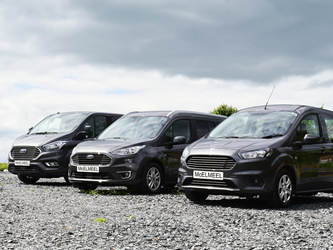Wheelchair Accessible Minibus
Wheelchair Accessible Minibuses typically refer to vehicles designed to house between 9 and 18 persons and are, as the name suggests, minibuses that are accessible to wheelchair users. The method of accessibility and wheelchair allocated space is relevant to the needs of the purchaser and most manufacturers offer a range of base vehicles can be converted to suit a wide variety of needs.
For the most up-to-date information on minibus permits and licensing please click here for UK and click here for Northern Ireland
- Who is using the minibus?
- Who is driving it?
- Where is it being driven?
- How many wheelchair passengers will you carry?
With a wide range of manufacturers, lengths, heights and finishes to choose from, the answer to the above questions will be very important in designing your new wheelchair accessible minibus.
Wheelchair accessible minibuses start as a base vehicle, designed to accommodate a certain amount of passengers, hence the names, for example, 15 seater minibus. This number loses its clarity a little when we talk about wheelchair accessible minibuses as in a typical conversion the seating is removed and a new crash tested floor is introduced to support the wheelchairs. Therefore an 18 seat minibus can also become a 12 seat wheelchair accessible minibus with 3 wheelchair spaces.
McElmeel Mobility Services are market leading conversion specialist with almost two decades experience in wheelchair accessible minibuses, so whether you want to have a new bespoke wheelchair accessible minibus or would like us to source a suitable second-hand option, please give us a call and we can have a chat to understand how we can best help you.
Information on buying a wheelchair accessible minibus
There are many things for you to consider if you are thinking about buying a wheelchair accessible minibus and the purpose of this summary is to make sure that, should you take the decision to buy a Wheelchair Accessible Minibus (WAM), you do so with the best information available.
Before you buy a WAM, we would ask if you have considered other possibilities first? Apart from the initial outlay, there are ongoing costs attached to running a WAM and these might outweigh the benefits of purchasing outright. If you have a regular local journey, you might consider using your local Community Transport Association. If you have longer but less regular requirements you could also seek to hire a Wheelchair Accessible Minibus. Ask McElmeel Mobility Services for more information about hiring a Wheelchair Accessible Minibus.
If you have done your homework and you believe that buying a WAM is the correct course of action, then the next thing you need to do is get your head around your financial options; do you use your reserves to purchase the vehicle, take out a loan, buy through hire purchase or take a vehicle on a lease hire agreement. Each of these four options has pro’s and con’s to them and depend wholly on your organisation’s financial standing and strategy.
Your budget and how you intend to finance your wheelchair accessible minibus is very important, as these two elements can dictate what you can and can’t do. Newer vehicles, comparatively speaking, should be easier to maintain and have lower fuel costs than their older counterparts, but all minibuses will have a monthly running cost that will sit beside any purchase cost. When you work out your overall and monthly budgets, you can then begin to see what you can get for your budget. If you would like some indicative figures of costs to help with setting your budget, please give us a call.
When you have your financial planning done, the next thing you need to look at is your design specification. There are many questions you need to answer in terms of setting the best internal layout for your needs and here at McElmeel Mobility Services we are happy to talk you through them if that helps. From standard questions about the number of wheelchair and non-wheelchair passengers you need to carry at any given time, to having an understanding of the needs of your passengers in terms of mobility, access and what they travel with, your minibus layout is very important. Understanding the most up to date legal requirements is also vitally important, as the comfort and safety of disabled passengers is an area of transport that the lawmakers are still trying to improve upon.
There are a range of manufacturers who build base vehicles which are suitable for the conversion to a wheelchair accessible minibus, and each vehicle will offer a set of options, with some suiting you more than others. Modern buses typically come with a good spec but it is important that you take nothing for granted. With each new release of a vehicle, the manufacturer adds some elements and removes others. Engine sizes and horsepower are coming down as manufacturers concentrate on better fuel economy and lower emissions but comfort and practicality is very important for users. Internal widths, lengths and heights are a key consideration, as are suspension and turning circle. "Payload" is the other key point of note and perhaps the one that causes most uncertainty. Again, if you have any questions about payload and allowances, please just give us a call.
When used on a non-commercial basis wheelchair accessible minibuses which fall under 3.5 tonne and can be driven by a B category (non-category D1) licence holder. Towing or roof-loading are not permitted on a B category license. It is vitally important that you understand how driver licenses impact on the expected usage. Non-UK driving is also a consideration that must be addressed. To drive a vehicle above 3.5 tonne GVW, either the driver must have the suitable class of license or the organisation needs to have a special permit. As more and more drivers do not have the required licences to drive minibuses over 3.5t, it is important that this is taken into consideration when you are setting the specification. If you need to set a tender to help you purchase a wheelchair accessible minibus, McElmeel Mobility Services, as independent conversion specialist, will be happy to assist you to set a fully transparent, inclusive tender document.
Sometimes you can bring your wish list together and find that your budget is not sufficient. This leaves you with a choice, increase your budget or re-examine your needs. Nearly new base vehicles might give you an opportunity to save you quite a few thousand and a second-hand vehicle might also be an option. McElmeel Mobility Services will do our utmost to put your needs first when we support you to get the vehicle you need.
Buying a wheelchair accessible minibus is rarely just about buying a bus. It involves working with a supplier who understands the needs you are communicating and gives you options about how to achieve this with a vehicle and a service that you can trust. Staying up to date with the changing legislation and ensuring that you are putting your passengers and drivers safety and comfort at the top of you priority is top of our priority. If you have any queries about new, used or second-hand wheelchair accessible minibuses, please do not hesitate to contact us.
Contact McElmeel Mobility
- (028) 3752 5333
- Message Us
-
McElmeel Mobility Group
15 Ballyscandal Road
Armagh
Northern Ireland
BT61 8BL

